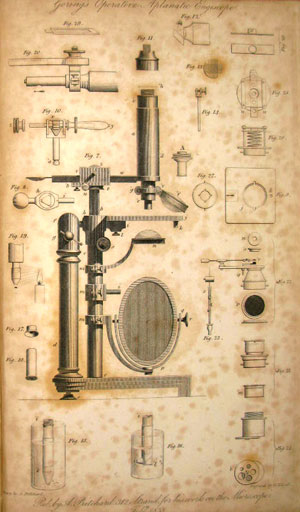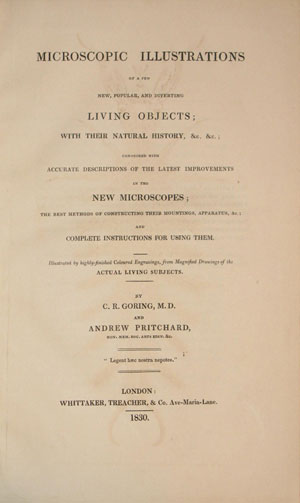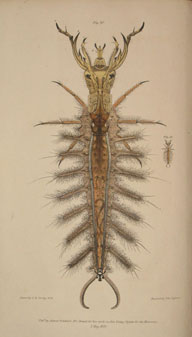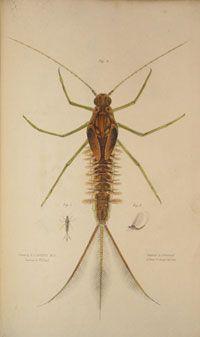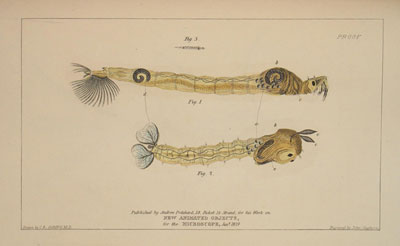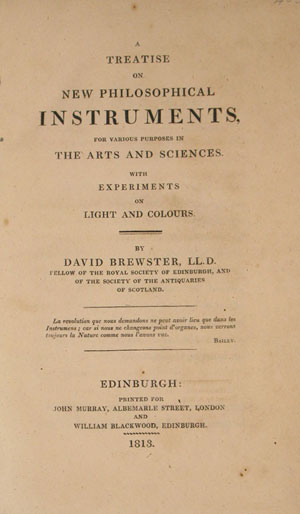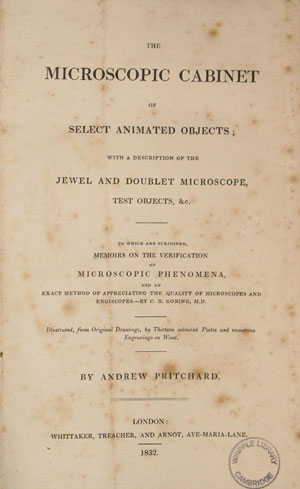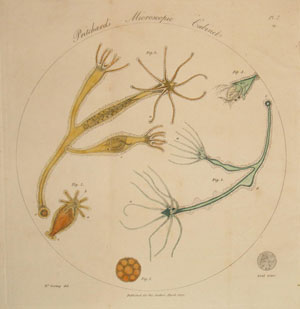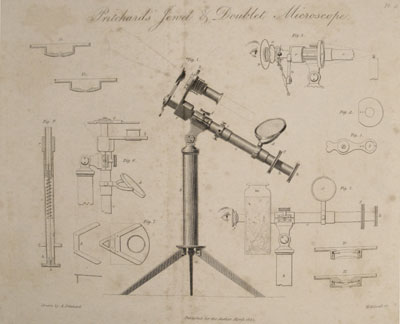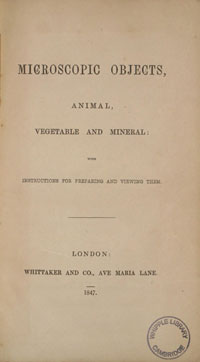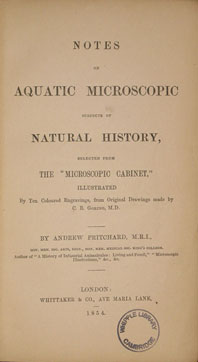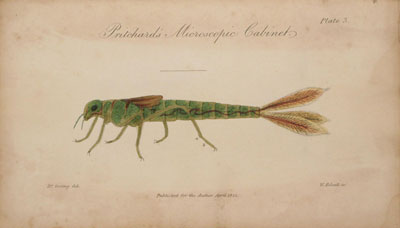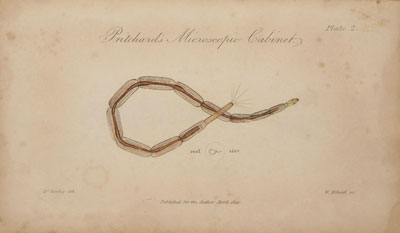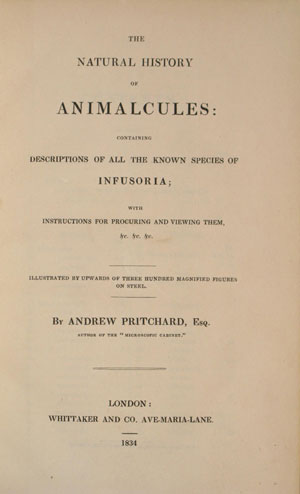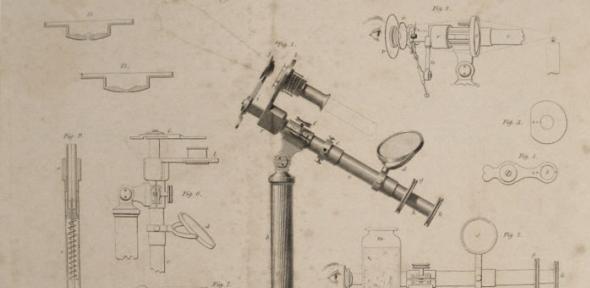
Microscope books of Dr C.R. Goring (1792–1840) and Andrew Pritchard (1804–1882)
Amongst the Whipple's many rare microscopy books may be found this beautifully illustrated series of publications written and published by C.R. Goring and Andrew Pritchard. Although he began his career as a London optician, Pritchard subsequently gained renown as a microscope maker and natural history author. In this he was encouraged by the medical practitioner and amateur microscopist Dr C.R. Goring.
During the 1830s Goring and Pritchard published several works that presaged and helped instigate the intense publishing activity that accompanied the heightened popularity of microscopy later in the 19th century. Pritchard and Goring's illustrated books are important for their pioneering exploration of natural history and for their espousal of an ultimately fruitless innovation in microscope development: the diamond lens microscope.
Andrew Pritchard and C.R. Goring
Microscopic illustrations of a few new, popular and diverting living objects with their natural history, &c. &c. (London : Whittaker, Treacher, & Co., 1830) CR 7:47, STORE TURNER 125, CR 7:46
This was Pritchard and Goring's most popular book, and was issued in several editions (three of which are included here). Its underlying agenda was to raise the standing of microscopy and natural science to equal that of astronomy and the telescope. Whilst Goring provided illustrations of insects and discussed philosophical issues raised by microscopy, Pritchard undertook 'the Department of natural history', with descriptions of insects, larvae and their behaviour.
C.R. Goring’s insect illustrations
Creating the original drawings of insects was not easy. Goring railed at the insects' 'incorruptible restlessness' which 'so balks and baffles the artist, that he is frequently compelled to lay down his pencil to regain his lost temper, and fresh courage to proceed'.
From Goring's drawings, these coloured engravings were made, which he proclaimed were 'the first colour ones on microscopic subjects which have been published in England'. Predating the era of mechanised colour printing, they were hand coloured, probably via a production-line process.
David Brewster (1781–1868)
A treatise on new philosophical instruments, for various purposes in the arts and sciences : with experiments on light and colours (J. Murray : W. Blackwood, 1813), STORE 16:17
Pritchard and Goring's books were concerned as much with developments in microscopy as in seeking to promote knowledge of natural history. A principal objective was to realise an idea first proposed in this book by David Brewster, the inventor of, amongst other things, the kaleidoscope. In his Treatise on new philosophical instruments Brewster claimed that although lens construction had been greatly improved any further improvement could only be achieved through 'the discovery of some transparent substance which, like diamond, combines a high refractive power, with low power of dispersion'. This prompted Goring to ask Pritchard to produce a diamond lens microscope.
Andrew Pritchard and C.R. Goring
The microscopic cabinet of selected animated objects : with a description of the jewel and doublet microscope, test objects, &c. (London : Whittaker, Treacher, and Arnot, 1832.) STORE TURNER 63
Here Pritchard and Goring sought to surpass their previous work with drawings 'more elaborate than any ever published on the subject, even exceeding those in the Microscopic Illustrations'. In addition to aquatic larvae they examined microscopic protozoan (which they termed 'animalcules'). In this Pritchard sought to draw attention to an area of inquiry he believed had been either 'overlooked' by naturalists or at worst 'delineated in the most incorrect and grotesque manner'.
Pritchard’s Jewel & Doublet Microscope as shown in The Microscopic Cabinet
Nineteenth-century England's fascination for the study of microorganisms had made optical development of the microscope an English preserve. Against this background Pritchard and Goring devoted much time to the development of lenses made of diamond and other precious stones. They sought to realise Brewster's notion of the jewel microscope as a means of counteracting two defects that had hampered the use of the existing compound microscope (i.e. a microscope containing two or more lenses). The first defect, known as chromatic aberration, resulted in a rainbow-effect caused by imperfections in the eyepiece lens and object glass.
The second defect, known as 'spherical aberration', resulted from a tendency of the object glass to confuse rays of light projected through the slide by the mirror light source beyond it. This made the edges of any object under observation appear indistinct. Goring and Pritchard became convinced that these defects could be rectified through the use of a 'single microscope', comprising one lens made of diamond or some other precious stone. It was believed that the higher refractive index of precious stones would allow for a shallower curved lens, thereby reducing aberration.
Unfortunately, despite Pritchard's hyperbole the innovation proved impractical as natural diamonds are too hard to work and most have flaws. Moreover, the jewel lens microscope was made obsolete by the invention of the doublet lens in 1828 by W.H. Wollaston (1766–1828) and work on the design of objective lenses for the compound microscope by Joseph Jackson Lister (1786–1869).
Andrew Pritchard
Microscopic objects, animal, vegetable and mineral : with instructions for preparing and viewing them (London : Whittaker and Co., 1847) STORE TURNER 60 Signed by the Author.
Andrew Pritchard and C.R. Goring
Notes on aquatic microscopic subjects of natural history : selected from the ‘Microscopic Cabinet.’ ...illustrated by ten coloured engravings (London : Whittaker & Co., 1854) STORE TURNER 26
These two books contain extracts from The Microscopic Cabinet which by the 1840s was no longer in print. Through them Pritchard sought to capitalise on the then growing market for cheap, popular microscope books, thereby conveying his work to a wider audience. Neither of these publications refers to the jewel microscope which by this time was discredited and obsolete.
Photo reproductions of illustrations published first in The Microscopic Cabinet and again in Notes on aquatic microscopic subjects. These appear to be colour engravings which have then been hand coloured. 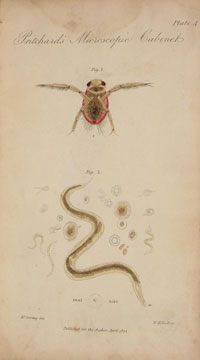
Andrew Pritchard
The natural history of animalcules : containing descriptions of all the known species of Infusoria : with instructions for procuring and viewing them (London : Whittaker and Co., 1834) STORE 108:7
Here Pritchard concentrated on 'Infusoria' a now outdated term for minute aquatic creatures such as protozoa and unicellular algae that exist in freshwater ponds. This was another little known area of natural science Pritchard sought to bring to the attention of scientists and public alike.

